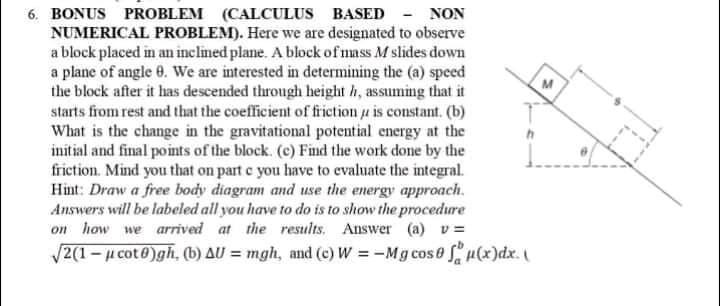6. BONUS PROBLEM (CALCULUS BASED - NON NUMERICAL PROBLEM). Here we are designated to observe a block placed in an inclined plane. A block of mass M slides down a plane of angle 0. We are interested in determining the (a) speed the block after it has descended through height h, assuming that it starts from rest and that the coefficient of friction u is constant. (b) What is the change in the gravitational potential energy at the initial and final points of the block. (c) Find the work done by the friction. Mind you that on part c you have to evaluate the integral. Hint: Draw a free body diagram and use the energy approach. Answers will be labeled all you have to do is to show the procedure on how we arrived at the results. Answer (a) v = M 2(1- u cot0)gh, (b) AU = mgh, and (c) W = -Mg cose u(x)dx.
6. BONUS PROBLEM (CALCULUS BASED - NON NUMERICAL PROBLEM). Here we are designated to observe a block placed in an inclined plane. A block of mass M slides down a plane of angle 0. We are interested in determining the (a) speed the block after it has descended through height h, assuming that it starts from rest and that the coefficient of friction u is constant. (b) What is the change in the gravitational potential energy at the initial and final points of the block. (c) Find the work done by the friction. Mind you that on part c you have to evaluate the integral. Hint: Draw a free body diagram and use the energy approach. Answers will be labeled all you have to do is to show the procedure on how we arrived at the results. Answer (a) v = M 2(1- u cot0)gh, (b) AU = mgh, and (c) W = -Mg cose u(x)dx.
Elements Of Electromagnetics
7th Edition
ISBN:9780190698614
Author:Sadiku, Matthew N. O.
Publisher:Sadiku, Matthew N. O.
ChapterMA: Math Assessment
Section: Chapter Questions
Problem 1.1MA
Related questions
Question
6

Transcribed Image Text:6. BONUS PROBLEM (CALCULUS BASED - NON
NUMERICAL PROBLEM). Here we are designated to observe
a block placed in an inclined plane. A block of mass M slides down
a plane of angle 0. We are interested in determining the (a) speed
the block after it has descended through height h, assuming that it
starts from rest and that the coefficient of friction u is constant. (b)
What is the change in the gravitational potential energy at the
initial and final points of the block. (c) Find the work done by the
friction. Mind you that on part e you have to evaluate the integral.
Hint: Draw a free body diagram and use the energy approach.
Answers will be labeled all you have to do is to show the procedure
on how we arrived at the results. Answer (a) v =
/2(1- µ cot0)gh, (b) AU = mgh, and (c) W = -Mg cose u(x)dx.
M
Expert Solution
This question has been solved!
Explore an expertly crafted, step-by-step solution for a thorough understanding of key concepts.
Step by step
Solved in 2 steps with 1 images

Knowledge Booster
Learn more about
Need a deep-dive on the concept behind this application? Look no further. Learn more about this topic, mechanical-engineering and related others by exploring similar questions and additional content below.Recommended textbooks for you

Elements Of Electromagnetics
Mechanical Engineering
ISBN:
9780190698614
Author:
Sadiku, Matthew N. O.
Publisher:
Oxford University Press

Mechanics of Materials (10th Edition)
Mechanical Engineering
ISBN:
9780134319650
Author:
Russell C. Hibbeler
Publisher:
PEARSON

Thermodynamics: An Engineering Approach
Mechanical Engineering
ISBN:
9781259822674
Author:
Yunus A. Cengel Dr., Michael A. Boles
Publisher:
McGraw-Hill Education

Elements Of Electromagnetics
Mechanical Engineering
ISBN:
9780190698614
Author:
Sadiku, Matthew N. O.
Publisher:
Oxford University Press

Mechanics of Materials (10th Edition)
Mechanical Engineering
ISBN:
9780134319650
Author:
Russell C. Hibbeler
Publisher:
PEARSON

Thermodynamics: An Engineering Approach
Mechanical Engineering
ISBN:
9781259822674
Author:
Yunus A. Cengel Dr., Michael A. Boles
Publisher:
McGraw-Hill Education

Control Systems Engineering
Mechanical Engineering
ISBN:
9781118170519
Author:
Norman S. Nise
Publisher:
WILEY

Mechanics of Materials (MindTap Course List)
Mechanical Engineering
ISBN:
9781337093347
Author:
Barry J. Goodno, James M. Gere
Publisher:
Cengage Learning

Engineering Mechanics: Statics
Mechanical Engineering
ISBN:
9781118807330
Author:
James L. Meriam, L. G. Kraige, J. N. Bolton
Publisher:
WILEY